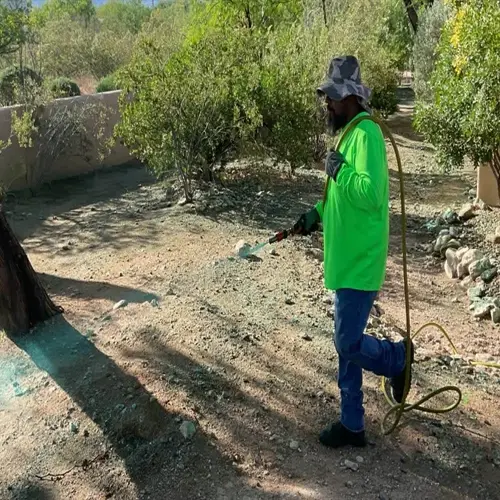Scale Insect Treatment Methods Explained

Written by
Benjamin Miller
Reviewed by
Prof. Martin Thorne, Ph.D.Treatment for scale insects starts with proper identification of which armored or soft type.
You can help keep infestations in check through consistent inspections of your plants and good environmental practices.
For early clusters of scales, the best method is removal by hand using alcohol swabs.
Horticultural oils can be applied at dusk to suffocate soft scale without chemicals.
@In extreme cases of armored scale, a systemic insecticide may treat the infestation but be cautious of pollinator safety prior to application.
It is a myth to believe that scales infest only unhealthy plants and/or that it will take several treatments to manage them completely.
Article Navigation
The first step in efficient scale insect treatment is to recognize these sap-sucking pests as more than just lumps on your plants. These pests attach themselves permanently and suck vital nutrients necessary for growth out of their host plants. If they are ignored, a trip causes the fast spreading and killing of the plants on which they attack. I have seen healthy orchids collapse within a few months due to overlooked infestations.
Numerous gardeners confuse scales for plant diseases. This, of course, leads to incorrect treatment, such as the use of fungicides. The control of scales requires ideals of pest control rather than disease procedure. Remember that scales are live insects, covered by armor, not fungal growths.
The path becomes clear: First identify the types of scale correctly. Next apply prevention strategies. Finally make choice of natural or chemical treatments. I will share with you the field tested methods that saved my citrus trees last season.
Types of Scale Insects
Comprehension of the various scale types is necessary to determine how to handle them effectively. Armored scales have hard shells for protection against sprays and hence are much more difficult to eradicate. Soft scales have waxy coverings and secrete a sticky honeydew which attracts ants and fungus. I have fought both of these in my greenhouse with very different results.
Mealybugs are a special subclass of soft scale, which you will recognize by their expansive appearance in white clusters at leaf joints and in stems. They are generally active and move about from place to place. Their visibility is an advantage for detection, but their cottony protection necessitates a thorough method of extermination.
Honeydew is a sugary waste product produced only by soft scales. It covers the leaves and stems of the plant. It is also responsible for making black, sooty mold. This mold blocks sunlight from reaching the leaves, thereby affecting the process of photosynthesis. The armored scales do not create this sticky waste, so soft, waxy scales are an indication in this instance.
The type of shell determines the ease of pest control. Armored scales require the use of systemic insecticides, which penetrate their shells. Soft scales require oil sprays, which suffocate them. For mealybugs, I find the best method is a combination of alcohol swabs and predatory insects, such as ladybugs.
Armored Scale
- Armored scales develop a rigid, protective shell that's not attached to their body, creating a shield against predators
- These insects do not produce honeydew, eliminating sooty mold concerns but making detection more challenging
- Control requires systemic insecticides or scale nematodes since their shell blocks contact pesticides effectively
Soft Scale
- Soft scales secrete a waxy coating that becomes part of their body, making them vulnerable to suffocation methods
- They produce sticky honeydew that attracts ants and promotes black sooty mold growth on plant surfaces
- Horticultural oils like neem can penetrate their coating when applied thoroughly to all infested areas
Mealybugs
- As soft-scale relatives, mealybugs appear as white cottony masses rather than traditional shell-like bumps
- Their larger size and mobility make them easier to identify compared to other scale insect varieties
- Treat with alcohol swabs directly on visible insects or introduce lacewings for biological control solutions
Oyster Shell Scale
- This armored scale variety forms distinctive oyster-shaped shells on tree bark and branches
- Commonly infests ash, maple, and dogwood trees causing dieback of twigs and branches
- Requires dormant oil applications in early spring before crawlers emerge for effective control
Cottony Cushion Scale
- Identifiable by large white egg sacs that resemble cotton balls along stems and leaf veins
- Favors citrus trees but also attacks ornamental plants like pittosporum and nandina
- Vedalia beetles provide effective biological control against this soft-scale species
How Scale Insects Damage Plants
Scale insects use their needle-like mouth parts to pierce food and suck many litres of sap, from which they get their food nutrient. Such constant feeding removes the essential potash and nitrogen from the plants, causing stunted growth and yellow leaves as the life sap is drained from them. I've seen hibiscus plants entirely lose their vitality in a few weeks in heavily infested areas.
Soft scales exude sticky honeydew while feeding, covering the surface of your plants. This sugary residue is a breeding ground for black sooty mold. The mold blocks out sunlight, severely cutting back photosynthesis. Affected plants can't produce enough energy for basic survival.
The feeding results in direct injury to the cells at the site of punctures, which tends to weaken the plant's tissues. This condition worsens as the tissues are repeatedly punctured, leading to dieback of the branches due to the failure of the vascular tissues. I have seen the bark of magnolias that have been infected become cracked. Thus these trees became susceptible to secondary infections.
When left unattended, progressive deterioration will inevitably follow a death curve. The plants show slight stress symptoms within the first few weeks. After approximately three months, signs of structural weakness will become apparent. Complete death occurs in 1 to 2 growing seasons. Early treatment will avoid this irrevocable decline and save your plants.
Nutrient Drainage
- Scale insects pierce plant tissues with needle-like mouthparts to extract nutrient-rich sap
- Continuous feeding depletes essential nutrients like nitrogen and potassium needed for growth
- This causes visible symptoms including leaf yellowing, stunted development, and premature leaf drop
Honeydew Production
- Soft scale insects secrete sticky honeydew while feeding on plant sap
- Honeydew coats leaves and stems, creating ideal conditions for fungal growth
- Black sooty mold develops on these surfaces, blocking sunlight and reducing photosynthesis
Cellular Destruction
- Feeding activity damages plant cells at puncture sites, weakening structural integrity
- Repeated infestations cause branch dieback as vascular tissues become irreparably damaged
- Severe cases lead to bark cracking and increased vulnerability to secondary infections
Secondary Pest Attraction
- Honeydew residue attracts ants that protect scale colonies from natural predators
- Sooty mold further stresses plants by limiting their ability to produce energy
- Weakened plants become susceptible to other pests like aphids and spider mites
Long-Term Consequences
- Persistent sap loss reduces plant vigor and flowering/fruiting capacity
- After 3-6 months of untreated infestation, terminal branches begin dying back
- Complete plant death typically occurs within 1-2 growing seasons without intervention
Identifying Scale Insects Accurately
To find scale insects, the distinct hard shell bumps found on the stems and leaf tops are to be looked for, which range from the size of a pin head to 1/8 inch in size and are brown, white, or black. When present in great density, they denote a ticklish condition. I have found the magnifying glass indispensable for a correct determination.
Look for sticky honeydew residue on leaves or surrounding surfaces. This clear material draws ants and causes black sooty mold to develop. Unlike plant diseases, scales always leave this sticky evidence to help confirm their presence on your plants.
Distinguishing between scales and diseases is of utmost importance. Diseases create spots or rot, leaving no sticky substance. Scales have migrating nymphs called crawlers that are almost invisible to the naked eye. I use white paper under branches and tap the stems to see if any of the translucent crawlers scatter out.
Buy a 10x magnifier to locate the eggs and nymphs that are hidden in the crevices. These almost invisible insects come out to develop into crawling pests. Early detection with the proper tools will eliminate truly dangerous infestations and save your plants from injury.
Visual Appearance
- Scale insects appear as small, immobile bumps ranging from 1/16 to 1/8 inch long
- Colors vary: brown, white, black, or orange, often blending with plant surfaces
- Clustered formations on stems, leaves, or bark are telltale signs of infestation
Honeydew Residue
- Sticky, clear substance secreted by soft scale insects during feeding
- Accumulates on leaves and stems below feeding sites
- Distinguishes scale from fungal diseases which don't produce residue
Sooty Mold
- Black fungal growth developing on honeydew-coated surfaces
- Blocks sunlight and reduces photosynthesis in affected plants
- Occurs exclusively with honeydew-producing pests like soft scale
Crawler Stage Detection
- Newly hatched nymphs are mobile and translucent, measuring 1/100 inch
- Detect by tapping branches over white paper or using sticky tape traps
- Critical identification phase before they settle and develop protective shells
Plant Response Signs
- Yellowing leaves and stunted growth indicate sap depletion
- Premature leaf drop occurs as infestations progress
- Dieback of terminal branches in advanced cases without treatment
Preventing Scale Infestations
Keeping scale at bay starts with rigid inspection protocols for any new plants added to your collections. Quarantine for two or three weeks, making daily inspection for bumps or sticky residue. I learned this lesson the hard way when I introduced several infected ferns to my greenhouse. Always inspect the lower side of the leaves with a magnifying glass before adding any new plants to your collection.
Reduce risk through environmental adjustments. Scales like it shady and warm. Ensure these plants receive at least six hours of light daily. The temperature should be cooler (60-70°F) during the winter months. Proper air circulation also helps prevent infestations in the home.
Hygiene is uncompromising. Disinfect pruning implements with 70% alcohol between all plants. Remove fallen leaves immediately, where scales lay eggs. Wipe plant surfaces monthly with diluted soap solution. For infested materials, I have specified cleaning cloths to avoid cross-contamination.
Strengthen natural resistance through balanced nutrition. Use potassium compounds to build up cell walls. Avoid excess nitrogen, which produces tender growth scales that are prone to love. Use liquid compost teas monthly to strengthen plant immunity. Well-fed plants withstand light infestations more than stressed ones.
Plant Inspection Protocol
- Examine new plants thoroughly for 2-3 weeks before introducing to garden
- Use 10x magnifier to check stems and leaf undersides for tiny crawlers
- Isolate infested plants immediately in separate rooms or outdoor zones
Environmental Optimization
- Ensure adequate sunlight: minimum 6 hours daily for vulnerable plants
- Maintain cooler temperatures (60-70°F/15-21°C) during low-light seasons
- Avoid over-fertilization: reduce nitrogen intake in winter months
Sanitation Practices
- Sterilize pruning tools with 70% isopropyl alcohol between plants
- Remove fallen leaves and debris where scale eggs may overwinter
- Wipe plant surfaces monthly with diluted soap solution
Nutrition Management
- Use balanced fertilizer (N-P-K ratio 10-10-10) during growing season
- Prioritize potassium-rich formulas to strengthen plant cell walls
- Apply compost tea monthly to boost natural defense mechanisms
Preventative Treatments
- Apply horticultural oil sprays in early spring before bud break
- Introduce ladybugs or lacewings as biological deterrents in greenhouses
- Use sticky traps to monitor and capture early crawler populations
Scale Insect Treatment Methods
There are two main kinds of effective scale insect treatment: one is natural, including physical removal of the scale insects and biological control with lady bugs, etc.; chemical scale insect treatments, including systemic insecticides, for bad scale infestations. I prefer the natural methods for edible plants but find I have to resort to chemical treatments for bad infestations of scale insects on trees, etc. after considering all factors.
The timing of insect control is critical. Effective treatment is directed against the crawler stage when the young scales are active, and therefore vulnerable. The oils or soaps should be applied at least once every 7-10 days to take advantage of the spring emergence. For outdoor plants, I make it a practice to apply oil or soap only after rain, when the temperature is below 85 degrees F. If this period of activity is missed, the shells harden, making control more difficult.
Always observe safety precautions. Apply sprays to small areas first, particularly on sensitive ferns or herbs. Avoid spraying during the bloom season to protect pollinators. Use gloves and masks when working with chemicals. I learned about plant sensitivity by using neem oil, which proved too harsh for my orchids.
Indoor treatments differ considerably from outdoor ones. For houseplants, isolate those in rooms, especially bathrooms, using the spread treatment. For garden plants, prune the over-infested branches before applying the spray. The chances of scale spreading are greater outdoors, so it would be advisable to prune before applying the biological controls. My patio lemon tree recovered after the strategic removal of branches.
Manual Removal
- Use soft toothbrush or cotton swab dipped in 70% isopropyl alcohol to scrub scales off plants
- Focus on visible clusters on stems and leaf undersides during early infestation stages
- Rinse plants under lukewarm water after treatment to remove dislodged insects and residue
Horticultural Oils
- Apply neem or rapeseed oil sprays at dusk to avoid leaf burn in direct sunlight
- Thoroughly coat all plant surfaces where scale insects are present for suffocation effect
- Reapply every 7-10 days for 3 weeks to target newly hatched crawlers emerging from eggs
Biological Controls
- Release lacewings or ladybugs in greenhouses at night when temperatures are above 50°F (10°C)
- Use scale nematodes for armored scale species by mixing with water and spraying soil/foliage
- Avoid chemical treatments for 8 weeks before introducing beneficial insects to prevent harm
Insecticidal Soaps
- Spray commercial insecticidal soap directly onto crawlers before protective shells develop
- Cover both upper and lower leaf surfaces completely until runoff occurs for full effectiveness
- Treat outdoor plants in early morning when temperatures are below 85°F (29°C) to prevent damage
Systemic Insecticides
- Use products like Bugclear Ultra for severe infestations by applying to soil for root absorption
- Protect pollinators by avoiding application during flowering periods and never spraying blooms directly
- Wait 8 weeks after treatment before introducing beneficial insects or consuming edible plant parts
5 Common Myths
Scale insects may resemble diseases of plants, so they should be treated with fungicides which will give better results than with the insecticides.
The scale insects are often mistaken for either fungi or plant diseases, because of the resemblance of their scaly covering to diseases, but they are sap-sucking pests, and require methods of insect control. Instead of too much juice there are frequently left sticky honey-dew and clusters of lumps, while the diseases which result in spots or rotting, no matter how abundant, do not leave an excess of substance, that is, of any kind which nature uses. But the scale insects are not touched by fungicides and their proper classification is of utmost importance before a treatment is begun.
Rubbing alcohol alone can completely eliminate all scale infestations without any physical removal at all.
While rubbing alcohol can kill scale insects upon contact, it must be applied in such a way, with physical scrubbing utilizing a soft brush or cotton swab, that they are able to penetrate their protective shells. However, alcohol dissipates rapidly and does not affect the hidden eggs and crawlers. For complete extermination, its use must be combined with physical removal and with repeated applications and supplemental treatments such as horticultural oils.
All scale insects excrete sticky honeydew waste which produces sooty mold on plants.
Only the soft scales and mealybugs produce honeydew to encourage black sooty mold. Armored scales do not possess this ability because of their impermeable shells, thus plants infested solely with armored scales do not develop sooty mold. This distinction is of paramount importance to the proper diagnosis and treatment programs. In other words, honeydew indicates the presence of soft scales.
It is possible with one treatment to eliminate scale insects permanently from infested plants.
Scale insects require a number of treatments because they breed and are protected by their shells. Eggs hidden beneath shells or in the soil usually survive until the first applications have been made, necessitating second treatments every 7 to 10 days during the period of emergence of the crawlers. In order to accomplish complete extermination of these insects it is necessary to give three to four treatments over a period of several weeks. It is also necessary to examine the plants during the time that the crawlers appear with some form of magnifying apparatus for the discovery of any new crawlers.
Always, weak or unhealthy plants are the ones infested with scale insects; healthy plants are naturally resistant to them.
Scale insects infest (or suck the sap) of healthy and ill-ventilated plants equally as they take sap, which they must have, irrespective of the vigor of the plant. The plants that are ill-ventilated succumb faster to a scale infestation, but healthy plants can harbor large colonies which will sap the plants and slowly weaken them, because they cannot stand the loss of sap except for a limited time. Prevention requires control through surveillance and atmosphere control as well as the proper nutrition of the plant.
Conclusion
The fundamental strategy to managing scale insects consists of the core identification-prevention-treatment cycle we have discussed. Identify them on sight, along with the other symptoms - discover the bumps and honeydew. Adopt preventive methods in conjunction with others in the case of quarantine. Finally, apply the logical treatment techniques. This systematic method saved my collection of rose plants from destruction last year.
Regular inspection is better than crisis treatment. Examine all the plants weekly with a glass, paying particular attention to the stem joints and undersides of the leaves. This inspection will catch the crawlers before their shells are formed. I spend only a few minutes each day inspecting the plants, saving many hours of crises in treatments later.
In your approach, prioritize environmental safety. Opt for ladybugs instead of toxic chemicals whenever you can. Test your sprays on isolated leaves first. Protect your pollinators by avoiding treatments while they are in bloom. My garden is healthy because I maintain a balance for pest prevention and ecological health.
You are now equipped to conquer scale infestations. Start small with one plant and use hand removal. Build your confidence with the visible results. All gardeners face this battle, but following these solutions, you can defend that green sanctuary.
External Sources
Frequently Asked Questions
How do I permanently eliminate scale insects?
Permanent removal requires combining manual scrubbing with alcohol swabs, horticultural oil sprays every 7-10 days, and introducing natural predators like ladybugs. Consistent treatment over 3-4 weeks disrupts their reproductive cycle by targeting both visible adults and hidden eggs.
What homemade solution kills scale insects effectively?
A highly effective DIY spray mixes 2 teaspoons of neem oil with 1 teaspoon liquid soap per quart of water. Apply thoroughly to all plant surfaces at dusk to suffocate scales without sun damage. For stubborn infestations, add isopropyl alcohol to penetrate shells.
Can scale insects spread to nearby plants?
Yes, scale insects spread through crawlers that move to adjacent plants or via contaminated tools. Isolate infested plants immediately and sterilize pruning equipment with 70% alcohol between uses. Ants transporting crawlers also accelerate spread across gardens and indoor collections.
When are scale insects most active?
Peak activity occurs during warm months when temperatures exceed 50°F (10°C), with crawlers emerging in spring/summer. Indoor plants face year-round risk, but vigilance increases in winter when heating reduces humidity. Eggs hatch fastest at 70-80°F (21-27°C).
What are the early signs of a scale infestation?
Key indicators include:
- Sticky honeydew residue on leaves or nearby surfaces
- Yellowing foliage and stunted new growth
- Small, immobile bumps clustered on stems or undersides
- Presence of black sooty mold developing on honeydew
Does hydrogen peroxide eliminate scale insects?
Hydrogen peroxide can kill surface-level scales but fails against eggs or deep infestations. Dilute 3% solution 1:1 with water and spray directly. However, it damages delicate plants and offers no residual protection. Combine with horticultural oils for better penetration.
Do scale insects live in soil?
Some species like ground pearls deposit eggs in soil, but most scales reside on plants. Soil-dwelling types attack roots, causing sudden wilting. Treat with systemic insecticides absorbed by roots or drench soil with nematodes targeting underground eggs and larvae.
How long do scale insects survive without treatment?
Infestations persist for months, with adults living 30-60 days while producing hundreds of eggs. Untreated, colonies cause plant death within 1-2 growing seasons. Regular monitoring catches early infestations before they become unmanageable.
Is neem oil safe for edible plants?
Neem oil is organic and safe for edibles if applied correctly. Spray at dusk to avoid leaf burn and wash produce before consumption. Avoid flowering stages to protect pollinators. Always test on a small area first for plant sensitivity.
Which natural predators control scale populations?
Effective biological controls include:
- Ladybugs and lacewings consuming up to 50 scales daily
- Parasitic wasps laying eggs inside scale bodies
- Scale nematodes applied as soil drenches
- Vedalia beetles targeting cottony cushion scales

